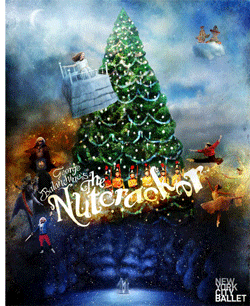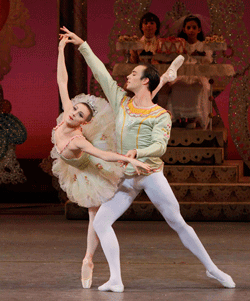$1.1 million revenue increase for The Nutcracker
The Scenario:

New York City Ballet (NYCB) was selling out most performances of the annual production of
The Nutcracker, but lacked opportunity to grow
Nutcracker sales and admissions because the Company was not able to add more performances. Director of Marketing Karen Girty had already built a solid marketing program, but she contracted TRG Arts in 2009 to help her find ways to maximize overall revenues, including
Nutcracker.
Need to maximize revenue from The Nutcracker.
Sales were flat for
The Nutcracker, which had traditionally been a staple blockbuster year after year. NYCB came to TRG with the question, “How do we make more from what we already have?” The Company wanted to maximize revenue on
The Nutcracker, and at 89% of seats sold, there was still opportunity to increase attendance as well as per-ticket revenue (also referred to as yield or per capita revenue).
Yield out of sync with demand.
When healthy demand management practices are in place, per-capita revenue (yield) rises with the demand for a show. For NYCB’s
The Nutcracker, per-capita revenues
decreased for performances with higher demand.
Matching price and demand.
NYC Ballet had priced certain performance days and times differently than others based on estimated sales that, in some cases, turned out differently than expected. In those instances, NYCB was missing opportunities—they could have sold more tickets at lower price points or earned more revenue for seats at the top of the price range. This was especially true for
The Nutcracker.
The Results:
New York City Ballet used TRG’s recommendations to increase revenue by $1.1 million for
The Nutcracker in 2012. Of that $1.1 million:
- The baseline TRG scale-of-house changes to NYCB’s hall map yielded a $600,000 increase over the same number of seats as sold the year before.
- Another $170,000 came from demand-based dynamic pricing changes during the run.
The remainder of that $1.1 million, about $330,000 came from NYCB selling approximately 3,000 more tickets than the previous season, coupled with fluid scale and pricing changes in an environment of high demand.
How New York City Ballet did it:
Thought partnership between Director of Marketing Karen Girty and TRG consultants led NYCB to tackle the following issues:
Pricing and scaling.
Using historical sales from each series, TRG analyzed how ticket buyers absorb each price point, reviewing the best, middle and bottom attended performances. This aided in “right-sizing” the scale-of-house plan. TRG adjusted the scale-of-house plan to make each house look full (even when it wasn’t) and to increase per capita revenue as more seats were sold for each performance. The scale-of-house changes increased gross potential for
The Nutcracker by 14%.

|
| Photo © Paul Kolnik |
Inventory and Revenue Management.
NYCB had an appetite to expand their dynamic pricing practices to adjust price section-by section. This was especially challenging to do because the box office was not NYCB’s own operation. Girty was able to pre-plan several pricing scenarios that allowed NYCB to nudge pricing up or down on each performance in each section in the ticketing system, maximizing her ability to quickly respond to demand.
Maximizing revenue on blockbusters.
At the consultants’ recommendation, NYCB made one price table for all
Nutcracker performances, a simpler structure that the Company could use to increase per ticket revenue through responsive adjustments to ongoing patron demand.
Consultants also focused on NYCB's “Sweet Seats” program that included Premium Orchestra seats (“the very best”), a keepsake color photo taken with a character from the production, a full-color souvenir book, and a 15% discount off NYCB merchandise at the gift shop. Sweet Seat prices were 66% more expensive than prime orchestra tickets, and demand for them was higher than anticipated. The Company started offering 130 Sweet Seats every night, and when they sold out, company-held seats were released at that price as well.
Added benefit:
With their gains in paid admissions for
The Nutcracker, NYCB launched a strategic retention effort aimed at getting holiday ticket buyers to come back for another performance during the season. This pool of same-season multiple ticket buyers has become a healthy pool of prospects for 2012-13 subscription and other engagement at NYCB. For example, Girty extended an offer to new Nutcracker buyers to incentivize them to buy later in the 2011-2012. This resulted in more than 500 returning households, totaling nearly $74,000 in sales--a 7.6% response rate. Offers such as these have continued throughout the season.
About NYC Ballet:
New York City Ballet is one of the foremost dance companies in the world, with an unparalleled active repertory of more than 150 works, most of which were created for NYCB, and many of which are considered modern masterpieces. The Company was established in 1948 by George Balanchine and Lincoln Kirstein, and quickly became known for its pure neo-classicism, which resonated with modern audiences. In 1949, Jerome Robbins joined the Company as associate artistic director and, with Balanchine, created a varied repertory that grew each season. Now under the artistic direction of Peter Martins, the Company has over 90 dancers, a 62-member orchestra, an official school (School of American Ballet) and an annual 23-week season at Lincoln Center’s David H. Koch Theater, which was built especially for the Company. Widely acknowledged for its enduring contributions to dance, NYCB is committed to promoting creative excellence and nurturing a new generation of dancers and choreographers.